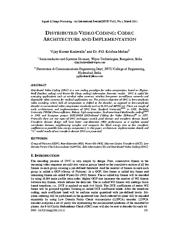A copy of this work was available on the public web and has been preserved in the Wayback Machine. The capture dates from 2018; you can also visit the original URL.
The file type is application/pdf.
Distributed Video Coding: CODEC Architecture and Implementation
2011
Signal & Image Processing An International Journal
Distributed Video Coding (DVC) is a new coding paradigm for video compression, based on Slepian- Wolf (lossless coding) and Wyner-Ziv (lossy coding) information theoretic results. DVC is useful for emerging applications such as wireless video cameras, wireless low-power surveillance networks and disposable video cameras for medical applications etc. The primary objective of DVC is low-complexity video encoding, where bulk of computation is shifted to the decoder, as opposed to low-complexity
doi:10.5121/sipij.2011.2111
fatcat:m2tmgcpiwjcnfl3wk7j454pb2u

